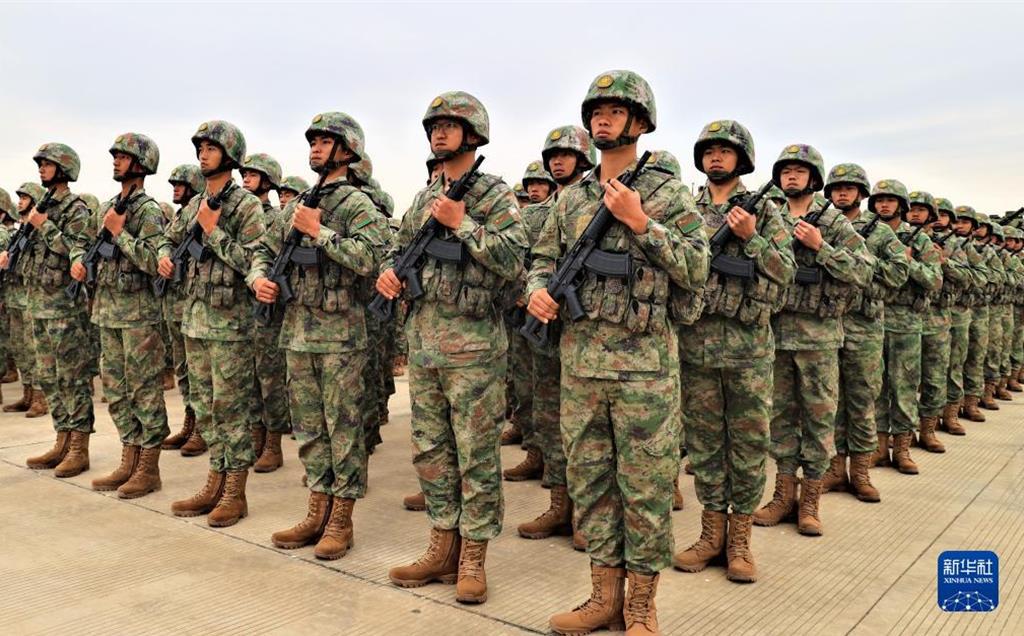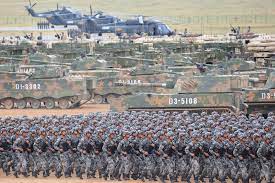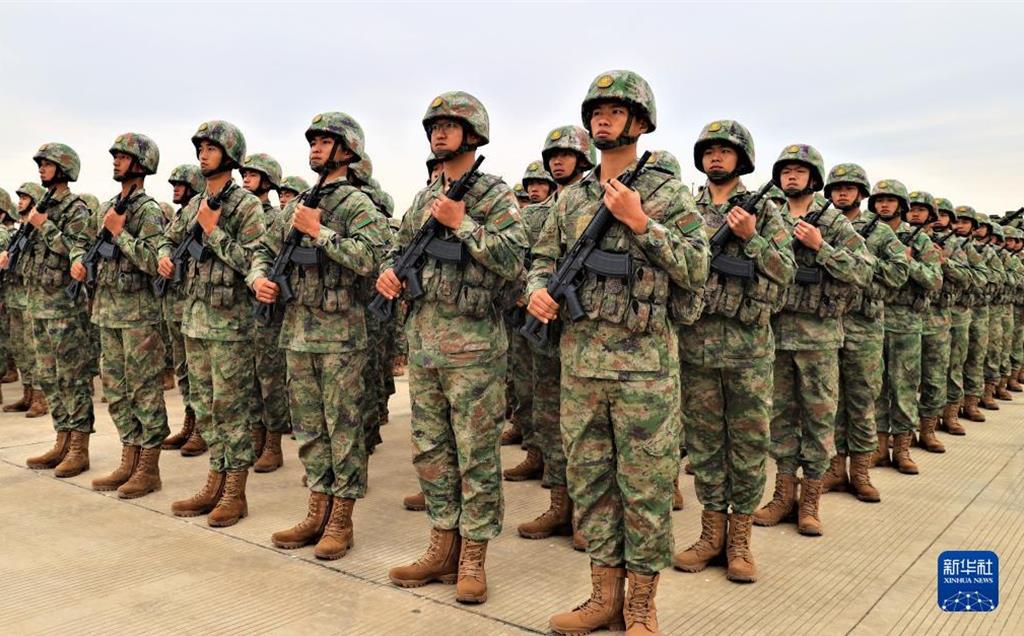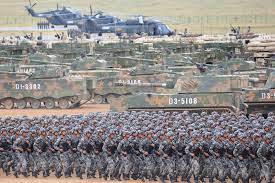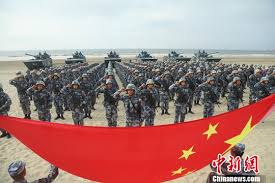中國軍事與認知對抗-價值攻與守:在認知領域設計戰鬥
現代英文音譯:
Value attack and defense is an important way to conduct cognitive domain operations from a strategic level. Usually, value attack and defense is achieved by intervening in people’s thinking, beliefs, values, etc., in order to achieve the purpose of disintegrating the enemy’s consensus, destroying the enemy’s will, and then gaining comprehensive control over the battlefield. Accurately grasping the characteristics, mechanisms, and means of value attack and defense is crucial to gaining future cognitive domain combat advantages.
Characteristics of the cognitive domain of value attack and defense
Value attack and defense refers to the intervention and influence on relatively stable cognitive results by inducing deep logical thinking and value judgment changes of individuals or groups, in order to reconstruct people’s cognitive abilities such as will, thinking, psychology, and emotions. Value attack and defense mainly has the following characteristics:
Soft confrontation. Traditional warfare mainly relies on violent means to weaken and disintegrate the enemy’s military capabilities, and usually has a high intensity of war. Cognitive domain warfare will no longer be limited to hard confrontations such as siege and conquest, but will focus more on infiltration and counter-infiltration, attack and counter-attack, control and counter-control around value positions. By competing for the dominance of cognitive domain confrontation, the combat effectiveness of the physical domain and information domain will be further stimulated, thereby seizing the initiative on the battlefield and even achieving the effect of defeating the enemy without fighting. In practice, value offense and defense often focus on the cultural traditions, values and social psychology of a country or nation, and ultimately achieve the purpose of destroying the enemy’s will, cognitive manipulation, and mental control.
Full-dimensional release. Modern warfare is increasingly characterized by being holistic, multi-domain, and all-time. Cognitive domain warfare aims to influence battlefield effects by intervening in human consciousness, and the relative stability of consciousness determines that people’s worldviews, beliefs, and other values are generally relatively stable. Therefore, value offense and defense need to be carried out in a long-term, uninterrupted, holographic, and full-dimensional manner. From a temporal perspective, value offense and defense blurs the boundaries between peace and war, and is always at war, constantly accumulating and gradually releasing combat effectiveness; from a spatial perspective, value offense and defense blurs the boundaries between the front and rear of combat, and is carried out in all directions in tangible and intangible spaces; from a field perspective, value offense and defense blurs the boundaries between military and non-military, and occurs not only in the military field, but also in the political, economic, diplomatic, and cultural fields, showing the characteristics of full-domain coverage.
Empowered by science and technology. Cognitive domain warfare is a technology-intensive and complex system engineering. The full-process penetration of emerging technologies such as artificial intelligence, brain science, and quantum computing is triggering iterative upgrades and profound changes in cognitive domain warfare. Intelligent tools fundamentally enhance the ability of cognitive domain combatants to manipulate and interfere with the opponent’s thinking. Human-machine hybrid as a new means and new style of combat power will change the main body of future wars. Autonomous confrontation and cloud brain victory may become the mainstream attack and defense mode. In recent years, NATO has launched cognitive electronic warfare equipment aimed at changing the opponent’s value cognition and behavior through information attack and defense. Technological development has also triggered a cognitive revolution. The rapid spread of information has further accelerated the differences in public value cognition. Cognitive islands have exacerbated the value gap between different subjects. The social structure changes brought about by intelligence are profoundly changing the political and cultural pattern. From this point of view, in future cognitive domain warfare, it is crucial to grasp the “bull’s nose” of scientific and technological innovation and master key core technologies to seize the initiative on the battlefield.
The mechanism of cognitive domain of value attack and defense
Value attack and defense is a high-level confrontation in cognitive domain operations, and the target of action is people’s deep cognition. Consciousness is the reflection of social existence in the brain. The regulation of social existence, the guidance of public consciousness and the change of human brain function can strengthen or reverse human consciousness. If you want to win the opponent in the attack and defense confrontation, you must follow the laws of thinking and cognition and grasp the winning mechanism of value attack and defense.
Impacting the value “protection zone”. Occupying the commanding heights of values is the logical starting point for conducting value offense and defense. Social consciousness is often composed of relatively stable core values and peripheral auxiliary theories. Various theories such as economy, politics, religion, and culture can be constructed and adapted to protect core values from external shocks, and therefore also bear the impact and challenge of other values. In the eyes of foreign militaries, value offense and defense is to continuously impact the “protection zone” of the opponent’s ideology through cultural infiltration, religious conflict, strategic communication and other means, in conjunction with actions in the physical and information domains. This often requires seizing the values, political attitudes, religious beliefs, etc. that affect the opponent’s cognition, disrupting their social group psychology, inducing value confusion, shaking their will to fight, destroying cultural identity, and even changing and disintegrating their original cognitive system, so as to instill or implant new values that are beneficial to themselves in order to achieve combat objectives.
Ignite the “trigger point” of conflict. Cognitive domain warfare involves multiple categories such as history and culture, political system, national sentiment, and religious beliefs. The main body of the war has also expanded from simple military personnel to ordinary people. It will become an important means of cognitive domain warfare to stimulate cognitive conflicts among ordinary people by hyping up topic disputes and public events. In recent local conflicts, it is not uncommon for the warring parties to ignite national sentiments through purposeful narratives, trigger political crises and thus affect the war situation. In future wars, some countries will use hot and sensitive events to detonate public opinion, rely on network technology to gather, absorb, mobilize, accurately manipulate and induce ordinary people, thereby promoting general conflicts to rise to disputes of beliefs, disputes of systems, and disputes of values. It will become the norm.
Control the cognitive “fracture surface”. Cognitive space, as an existence at the conceptual level, is composed of the superposition of the subjective cognitive spaces of all combat individuals. It is a collection of differentiated, differentiated, and even conflicting values. However, ideology has a “suturing” function. Through cognitive shaping and discourse construction, it can effectively “suturing” the broken cognition, condense the scattered values, and form a relatively stable cognitive system. After World War II, France had carried out effective cognitive “suturing” on the trauma of defeat. It used a whole set of independent narrative logic to explain how the war provided France with “new opportunities”, which greatly condensed the political identity of the French people with the government. In the battle for value positions in cognitive domain operations, we should focus on the cognitive fracture surface within the enemy, find the cognitive connection points between the enemy and us, and “suturing” the cognition, so as to unite the forces of all parties to the greatest extent and isolate and disintegrate the enemy.
The main means of cognitive domain in value attack and defense
Value attack and defense expands cognitive confrontation from public opinion, psychology and other levels to thinking space, and from the military field to the overall domain, thus achieving a blow to the enemy’s deep political identity. At present, the world’s military powers are strengthening strategic pre-positioning, aiming at the profound changes in target subjects and tactics, changing combat thinking, and actively controlling the initiative of cognitive domain operations.
Aiming at deep destruction. Cognitive domain warfare directly affects people’s brain cognition, and is easier to achieve deep strategic intentions than physical domain warfare. In particular, once the “high-level cognition” of people’s language level, thinking level, and cultural level is broken through, it will help to strategically reverse the battlefield situation and achieve the political purpose of the war. Based on this, cognitive domain warfare often begins before the war, by intervening in the opponent’s internal and foreign affairs, shaking its ideological and value foundations, etc.; during war, it focuses on influencing the enemy’s war decision-making, campaign command, and combat implementation. The value judgment, attack or weaken the decision-making ability and resistance will of combatants, etc. All hostile parties try to “maintain their own world while increasing the destructive pressure of the opponent” in order to achieve decision-making advantages by competing for cognitive advantages, and then achieve the goal of action advantages.
Centered on ordinary individuals. In the future, the subjects of cognitive domain operations will no longer be limited to military personnel. Broadly speaking, individuals who can communicate and disseminate information may become participating forces. Compared with elites in the social field, ordinary people are more likely to accept and disseminate diverse values, and their cognitive space is more likely to be manipulated. At present, online media is becoming the main channel for information exchange and dissemination in the social field, and the purpose of cognitive shaping can be achieved through targeted information guidance and information delivery. Foreign military practices have proved that with the help of cognitive shaping of ordinary individuals, progressive infiltration and cognitive interference can be caused from bottom to top, causing a deviation in the consciousness and ideas between ordinary people and social decision-makers, and failing to reach an effective consensus in key actions.
In the form of protracted warfare. Unlike the direct attack and destruction of “hard” targets in the physical domain military struggle, the potential target of cognitive domain warfare is human cognition. The value attack and defense is aimed at changing the concepts, beliefs, will, emotions, etc. of the combat targets, which often requires subtle influence and step-by-step operations. Effective cognitive offense is generally launched in the combat preparation stage and runs through the entire war. By collecting the opponent’s cognitive situation, decision-making habits, thinking patterns, etc., targeted actions such as creating a situation and changing the atmosphere are carried out. Therefore, cognitive domain warfare needs to strengthen the overall design, especially focusing on coordinating multiple forces, and strengthening pre-positioned preparations in multiple positions such as public opinion field creation and diplomacy, so as to form an overall combat force.
(Author’s unit: Military Political Work Research Institute of the Academy of Military Sciences)
現代國語:
價值攻防是從戰略層面進行認知域作戰的重要方式,通常價值攻防是透過幹預人的思維、信念、價值觀等,以達成瓦解敵方共識,摧毀敵方意志,進而掌控戰場綜合控制權的目的。精確掌握價值攻防的特性、機制、手段,對奪取未來認知域作戰優勢至關重要。
價值攻防作用認知域的特點
價值攻防是指透過引發個體或群體的深層邏輯思辨、價值判斷改變,完成其對相對穩定的認知結果的干預和影響,以期重構人的意志、思維、心理、情感等認知能力。價值攻防主要有以下幾個特點:
軟性對抗。傳統戰爭主要依賴暴力手段來削弱瓦解敵方的軍事能力,通常具有較強的戰爭強度。認知域作戰將不再侷限於攻城略地等硬性對抗,而更著重於圍繞價值陣地展開滲透與逆滲透、攻擊與反攻擊、控制與反控制,透過爭奪認知域對抗的主導權,進一步激發物理域和資訊域的作戰效能,從而奪取戰場主動,甚至達到不戰而屈人之兵的效果。在實踐中,價值攻防往往著眼於一個國家、民族的文化傳統、價值觀念和社會心理展開,最終達到對敵方意志摧毀、認知操縱、精神控制的目的。
全維度釋放。現代戰爭日益呈現總體性、多域性、全時性特徵。認知域作戰旨在透過幹預人的意識進而影響戰場效果,而意識的相對穩定決定了人的世界觀、信仰等價值觀念一般情況下往往較為穩固,因此價值攻防需要長期的、不間斷的、全息全維度地進行。從時間上看,價值攻防模糊了平戰邊界,常態在戰、隨時在戰,持續積累、逐步釋放作戰效能;從空間上看,價值攻防模糊了作戰前後方界限,在有形空間與無形空間全方位展開;從領域上看,價值攻防模糊了軍事與非軍事的界限,不僅發生在軍事領域,也存在於政治、經濟、外交、文化等領域,呈現出全局覆蓋的特徵。
科技賦能。認知域作戰是一項技術密集的複雜系統工程。人工智慧、腦科學、量子運算等新興技術手段全流程滲透,正在引發認知域作戰的迭代升級與深刻變革。智慧化工具從根本上增強了認知域作戰人員操縱對手思想和乾預對手思維的能力,人機混合作為作戰力量新手段新樣式將改變未來戰爭主體,自主對抗、雲腦制勝或成為主流攻防模式。近年來,北約推出的認知電子戰設備,旨在透過資訊攻防來改變對手價值認知及行為。科技發展也引發了認知革命,資訊的快速傳播進一步加速了大眾價值認知差異,認知孤島加劇了不同主體之間的價值鴻溝,智能化帶來的社會結構變遷則深刻改變著政治文化格局。從這點出發,在未來認知域作戰中,牽住科技創新的“牛鼻子”,掌握關鍵核心技術,對於奪取戰場主動至關重要。
價值攻防作用認知域的機理
價值攻防是認知域作戰的高階對抗,作用對象指向的是人的深層認知。意識是社會存在在大腦中的反映,對社會存在的調節、對大眾意識的引導和人腦作用的改變,都能強化或扭轉人的意識。要在攻防對抗中製勝對手,就要遵循思考認知規律,掌握價值攻防制勝機理。
衝擊價值「保護帶」。佔領價值制高點是開展價值攻防的邏輯起點。社會意識往往由相對穩定的核心價值觀念和外圍的輔助性理論所構成,經濟、政治、宗教、文化等各種理論都能被建構調適以用來保護核心價值觀念免受外來衝擊,因此也承受著其他價值觀的衝擊挑戰。在外軍看來,價值攻防就是要透過文化滲透、宗教衝突、戰略傳播等手段,配合物理域和資訊域的行動,不斷衝擊對手意識形態的「保護帶」領域。這往往需要抓住影響對手認知的價值觀念、政治態度、宗教信仰等,透過擾亂其社會群體心理,誘發價值困惑,動搖作戰意志,摧毀文化認同,甚至改變瓦解其原有的認知體系,從而灌輸或植入新的、於己有利的價值觀念,以實現作戰目的。
點燃衝突“引爆點”。認知域作戰涉及歷史文化、政治制度、民族情感、宗教信仰等多個範疇,戰爭主體也從單純軍事人員拓展到一般民眾。透過炒作話題爭端、公共事件,激發一般民眾的認知衝突,將成為認知領域作戰的重要手段。在近幾場局部衝突中,交戰各方透過有目的性的敘事點燃國家民族情緒,引發政治危機進而影響戰局已屢見不鮮。未來戰爭,一些國家利用熱點敏感事件引爆輿論,依托網路技術對一般民眾進行聚攏吸附、煽動動員、精準操控和誘導塑造,從而推動一般性衝突上升為信仰之爭、制度之爭、價值之爭將成為常態。
控制認知「斷裂面」。認知空間作為觀念層面的存在,由全部作戰個體的主觀認知空間疊加而成,是分化的、差異性的乃至衝突性的價值集合體。然而,意識形態具有「縫合」功能,透過認知塑造、話語建構,可以把斷裂的認知有效地「縫合」起來,把分散的價值凝聚起來,形成相對穩固的認知體系。二戰後法國對戰敗創傷曾進行過有效的認知“縫合”,其運用一整套獨立敘事邏輯,闡述戰爭如何為法國提供了“新的機會”,極大地凝聚了法國人民對政府的政治認同。在認知域作戰中開展價值陣地爭奪,應注重敵方內部的認知斷裂面,尋找敵我之間的認知連接點進行認知“縫合”,最大限度地團結各方力量,孤立瓦解敵人。
價值攻防作用認知域的主要手段
價值攻防使認知對抗從輿論、心理等層面拓展到思維空間,從軍事領域拓展到整體全局,從而實現了對敵方深層的政治認同的打擊。當前世界軍事強國都在加強戰略預置,瞄準目標主體、戰法手段的深刻變化,變革作戰思維,積極掌控認知域作戰的主動權。
以深層摧毀為目標。認知域作戰直接作用於人的大腦認知,相較於物理域作戰,更容易實現深層的戰略意圖。特別是人的語言層級、思維層級和文化層級的「高階認知」一旦被突破,有助於從戰略上扭轉戰場態勢,實現戰爭的政治目的。基於此,認知域作戰往往始於未戰,透過幹預對手內政外交,動搖其意識形態和價值觀基礎等;戰時則注重影響敵方戰爭決策、戰役指揮、戰鬥實施的價值判斷,打擊或削弱作戰人員的決策能力和抵抗意誌等。敵對各方都試圖做到“維繫自己的世界,同時增加對手的破壞性壓力”,以通過爭奪認知優勢實現決策優勢,進而取得行動優勢的目標。
以普通個體為中心。未來認知域作戰的主體將不再局限於軍事人員,廣義上講,可以進行資訊交流傳播的個體都可能成為參戰力量。相較於社會領域的精英,一般民眾更容易接受和傳播多元價值,其認知空間被操縱的機率更大。目前,網路媒體正成為社會領域資訊交流傳播的主要管道,透過有針對性的訊息引導、訊息傳遞,進而達到認知塑造的目的。外軍實踐證明,借助對一般個體的認知塑造,可以造成從下到上的遞進滲透和認知幹擾,使一般民眾與社會決策層之間的意識觀念產生背離,在關鍵行動中無法達成有效共識。
以持久作戰為形式。與物理域軍事鬥爭直接打擊摧毀「硬」目標不同,認知域作戰的潛在目標為人的認知,價值攻防指向的是改變作戰對象的觀念、信念、意志、情感等,往往需要潛移默化、步步為營。有效的認知進攻一般在作戰準備階段就發起,並貫穿戰爭始末,透過收集對手的認知態勢、決策習慣、思考模式等情況,有針對性地進行營造態勢、改變氛圍等行動。因此,認知域作戰更需要加強整體設計,尤其要注重協調多方力量,在輿論場營造、外交等多個陣地多點強化預置準備,進而形成整體作戰合力。
(作者單位:軍事科學院軍事政治工作研究院)
中國軍事原文來源:https://www.81.cn/jfjbmap/content/2022-08/02/content_321888.htm









